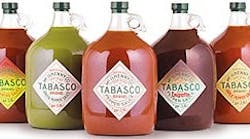There’s something to whet everyone’s appetite in exotic New Orleans. Jambalaya, crawfish étouffée and savory filé gumbos, heaping po’ boy sandwiches, a muffuletta from Central Grocery, red beans and rice, fried catfish or ‘gator, just-shucked shrimp, savory andouille sausage, sweet pralines — all Crescent City classics. Of course, they all are best focused on either crack-of-dawn or late-night visits to Café Du Monde, hunched over steaming chicory café with a plateful of beignets, those delectable square doughnuts, covered with powdered sugar that ends up dusting your face and lap.Serious food aficionados flock to the Big Easy to sample classic Oysters Rockefeller at Antoine’s, where it was created in 1899 in honor of John D. Rockefeller, one of the richest men in the world at that time. Other delicacies include: Pompano en papillote - fish in a parchment bag cooked in a special wine sauce at Arnaud’s; Eggs Benedict with the perfect hollandaise sauce or Bananas Foster, two trademark creations of Brennan’s; Turtle Soup Au Sherry at Commander’s Palace; Côtes D'Agneau Grillées, served with Sauce Choron at Louis XVI Restaurant; the trademark Trout Marguery, a rolled fillet of poached trout paired with shrimp, mushrooms and hollandaise sauce or Galatoire's fresh pompano topped with sautéed crabmeat. For more modern eaters there’s a "blackened" dish at Alex Patout’s Restaurant, but it isn’t fish. Look for blackened brie in a crisp salad of fresh greens with blueberry vinaigrette.
Jambalaya refers to a variety of rice-based dishes common in both Cajun and Creole cooking. They contain rice in stock, with green peppers, onions, celery and hot peppers. Anything else is optional. Standard additions are smoked Andouille sausage, chicken, seafood (especially shrimp or crawfish) onions, bell peppers, celery and tomato. Creole-style jambalayas use a red stock while Cajun-style jambalayas generally contain brown stock.Crawfish, also called crayfish, crawdads, hillbillies or mudbugs, are no more fish than a catfish is a cat, and only Yankees and tourists call them crawfish. If you ask for crawfish in a New Orleans restaurant, they'll automatically ask, "Where are you from?" Crawfish are freshwater crustaceans closely related to the lobster and a great favorite in Louisiana, often called the "crayfish capital of the world." Crayfish, found in gumbo and étouffée, are prepared like lobster and, like lobster, turn bright red when cooked. They're usually eaten with the fingers, and the sweet, succulent meat must be picked or sucked out of the tiny shells. Its flavor is delicate and its fat enriches sauces.Anything blackened, fried and smothered in sauce, plus combinations of food you would never dream of eating at the same time, is the essence of Cajun/Creole cuisine.Just as jazz, characterized by syncopated rhythmic patterns and untamed improvisation, originated in New Orleans in 1900, the city’s food is an improvisation, a potpourri of flavors and aromas from a multitude of cultures joined together to bring pleasure to the palate. So, enjoy each bite — slowly — and, as Louisianans say, “Laissez les bons temps roulez (let the good times roll).”
| Firs’ Ya’ Make da Roux True Cajun cooks use equal parts flour and oil (or pork fat), stirred and cooked to a dark brown. Preparation of a dark roux for gumbo and étoufée is probably the most complicated procedure in Cajun cuisine, involving slowly cooking fat and flour, constantly stirring for about 15-45 minutes (depending on the desired color) until the mixture has darkened and develops a nutty flavor. There are three basic types of roux, with some variations, usually expressed in terms of color. Generally, blond or light roux for gumbo in Creole cooking takes five minutes to prepare; medium or peanut butter colored roux for gumbo in Creole cooking takes 10 minutes; and dark roux with a smoky, roasted hazelnut flavor, typical of Cajun cooking, takes 25 minutes or up to an hour over low heat. It has less thickening power but adds more flavor. The principle is simple: The more you cook a roux, the darker it gets. Roux has to be stirred constantly with a whisk or paddle. If little black specks appear, your roux is burnt and you have to start over. Stir carefully, however, because roux isn't called "Creole napalm" for nothing. The smallest spatter of hot roux burns your skin. |
BRINGING LOUISIANA'S RICHES TO THE HOME TABLE A Hot Time in the Old Town Tonight To get that authentic Louisiana taste in any food, Tabasco is king. Made on Avery Island in Louisiana by the McIlhenny family since 1868, it is used as a table sauce and as a flavoring in cooking. Tabasco brand pepper sauce (www.tabasco.com) is made with only three ingredients: fully aged red peppers, high-grain vinegar and a small amount of salt mined right on Avery Island. The pepper mash is allowed to ferment and age for up to three years in white oak barrels, much like wine, and a member of the McIlhenny family inspects every batch for color and aroma before final production. Tabasco’s Scoville Unit rating is 2,500 – 5,000, which means it's hot. (The Scoville unit is a measure of capsaicin, the chemical in hot peppers responsible for their heat.) Jazz Up Dinner Tonight Gretna, La.-based Zatarain’s (www.zatarain.com) is the nation’s leading maker of New Orleans-style food. It has a large variety of seafood boils, breadings, condiments and sauces, pasta dinner mixes, ready-to-serve mixes, rice dinner mixes, seasoning and spices, side dishes, stuffing mixes and even root beer extract. In the Bag Cajun Chef John Folse (www.jfolse.com), Gonzalez, La., provides a variety of Cajun and Creole seasonal seafood, meats, cheese, seasonings and mixes, old world bread and desserts and soups and entrees — including crawfish étouffées — packaged in sealed plastic boiling bags. Creole Caché Opelousas, La.-based Tony Chachere's Creole Foods (www.tonychachere.com) began in 1972 as a retirement hobby for South Louisiana Chef Tony Chachere. Still family owned and operated, it has become one of the largest brands in Creole foods. Chachere semi-retired from the operations of his food company at age 76, in 1981, and continued to perfect his recipes and develop new food products, which include seasoning blends, boxed dinner mixes, gravy mixes, fry batters and marinades. A glowing climax to his career in the culinary arts came in March 1995 when his colleagues in the American Culinary Federation honored him as the first inductee in the Louisiana Chefs Hall of Fame. He died one week later at 89. Ragin’ Cajun Chef Emeril Lagasse sells a variety of his Essence spices and rubs, specialty sauces, salad dressings, pasta sauces, bastings, marinades, salsas, coffee and mustards at www.emerils.com and at selected retailers. Recently he began selling wild-caught frozen fresh shrimp. Makin’ Magic Accommodating his many customers and fans, Chef Paul Prudhomme’s (www.chefpaul.com) Magic Seasoning Blends, New Orleans, provides seasoning blends, salts, marinades, pepper sauce, rice mixes, red beans & rice, Louisiana rice, dried chilies, desserts, coffee, smoked meats and sauce concentrates to both processors and consumers. |
LEXICON OF LOUISIANA CULINARY TERMS Andouille (ahn-DOO-wee) — Lean Cajun pork sausage with a spicy smoked flavor. Beignet (bain-YAY) — A square French doughnut, deep-fried and sprinkled with powdered sugar. Bisque (bisk) — Thick, cream- or milk-based shellfish soup, usually made with crawfish, shrimp or oysters. Boudin (BOO-dan) — A Cajun favorite made by cooking ground pork rice and seasonings and stuffing the mixture into a casing. It is then cut like sausage and eaten. Bouilli (boo-YEE) — French for “boiled,” is a stew made from boiled meats. Spelled with an “e” at the end (bouillie) it means boiled-milk custard. Bourre (boo-ray) — French for “stuffed,” is the name of a Cajun card game, which requires the loser of a hand to stuff the pot with chips. Couche-couche (koosh-koosh) — Popular breakfast food, made by frying cornmeal and topping it with milk and/or cane syrup. Dirty Rice – A typical Cajun dish of very spicy rice with finely ground meats. Etouffee (AY-too-FAY) — Gravy made by smothering seasoned vegetables. It is the ultimate Cajun dish, usually made with seafood in a smothered vegetable sauce. Filé (FEE-lay) — Spice made from powdered sassafras leaves and used as a garnish for gumbo. Fricassee (FREE-ke-SAY) — Stew made by browning, then removing meat from the pan, making a roux with the pan drippings, and then returning meat to simmer in the thick gravy. Grillades (GREE-yahdz) — Diced beef round, veal or pork marinated for several days in vinegar. Yields a rust-colored gravy (sauce rouillee) when cooked. Traditionally served for brunch with grits. Gumbo (GUM-boh) — Roux-based soup of poultry, sausage, or seafood, served over rice. Jambalaya (jum-buh-LIE-yuh) — Main dish, similar to paella, usually made from rice and a combination of meats. Lagniappe (lon-YOP) — "Something extra," an unexpected treat or favor. Maque Chou (mock-shoo) — Dish made by scraping young corn off the cob and smothering the kernels in tomatoes, onion and spices. Mirliton (mer-lee-tawn) — Vegetable pear, or chayote. Pain Perdu (PAHN pear-DOO) — "lost bread," French toast Po’boy — Sandwich made of meats stuffed in a length of French bread. Roux (roo) — base for gumbo or stews made of flour browned in oil. Sauce Piquante (SAWS-pee-KAWNT) — "spicy sauce" Tasso (TAH-soh) — Strips of spiced pork or beef, which are smoked like jerky and used to flavor many dishes; a sort of Cajun pepperoni. Source: Tony Chachere’s Creole Foods |


